Search Result
Results for "
tyrosinase activity
" in MedChemExpress (MCE) Product Catalog:
6
Isotope-Labeled Compounds
| Cat. No. |
Product Name |
Target |
Research Areas |
Chemical Structure |
-
- HY-161289
-
|
|
Tyrosinase
|
Cancer
|
|
Tyrosinase-IN-24 (compound 3b) is a tyrosinase inhibitor with inhibitory activity against mushroom tyrosinase .
|
-
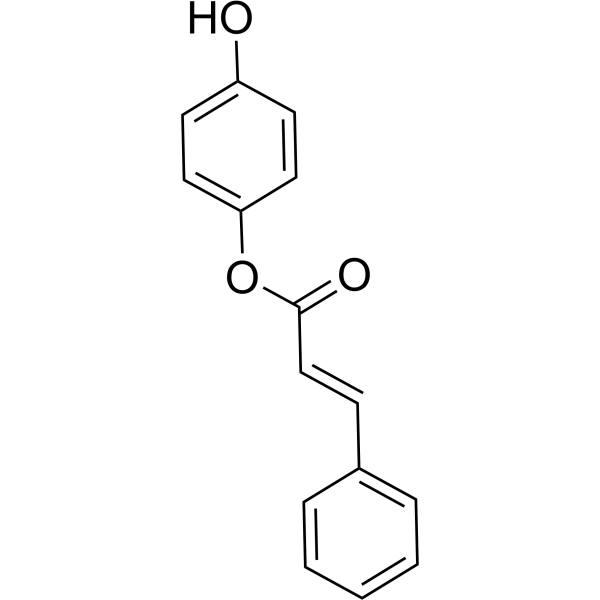
-
- HY-155247
-
|
|
Tyrosinase
|
Others
|
|
Tyrosinase-IN-14 (compound 7m) is a tyrosinase inhibitor that reduces the catalytic activity of tyrosinase by changing its secondary structure. Tyrosinase-IN-14 has low cytotoxicity and anti-browning activity in fruits. Tyrosinase-IN-14 effectively inhibits banana browning during storage .
|
-

-
- HY-157124
-
|
|
Tyrosinase
|
Metabolic Disease
|
Tyrosinase-IN-19 (compound 9) is a competitive tyrosinase inhibitor. Tyrosinase-IN-19 has strong antioxidant activities against ROS, ABTS+, and DPPH radicals. Tyrosinase-IN-19 suppresses tyrosinase expression in a dose-dependent manner .
|
-
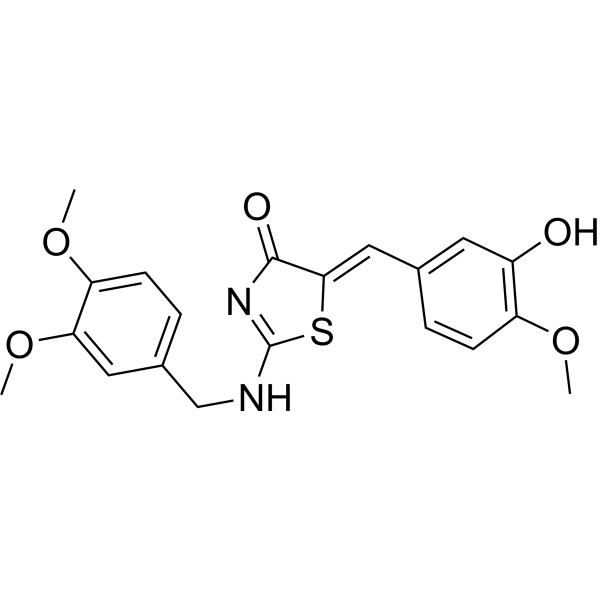
-
- HY-149207
-
|
|
Tyrosinase
|
Metabolic Disease
|
|
Tyrosinase-IN-11 is a potent tyrosinase inhibitor with IC50s of 50 nM and 64 nM for L-tyrosinase and L-dopa, respectively. Tyrosinase-IN-11 has significant antioxidant activity and low cytotoxicity. Tyrosinase-IN-11 has the potential for skin hyperpigmentation research .
|
-
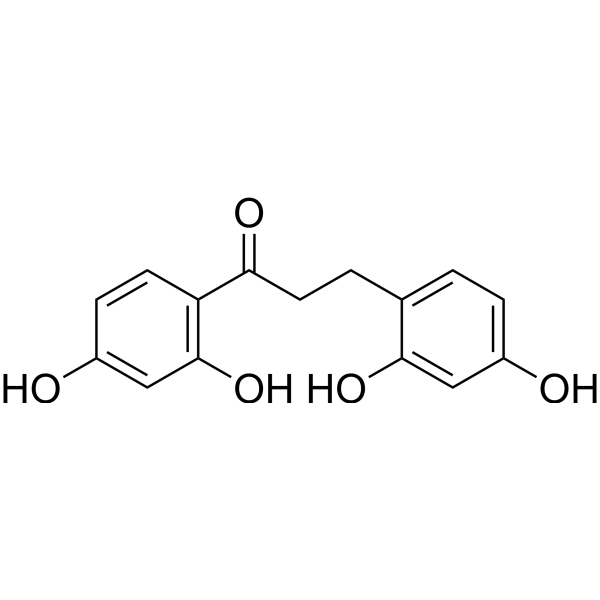
-
- HY-157123
-
|
|
Tyrosinase
|
Others
|
Tyrosinase-IN-18 (compound 6) is a potent tyrosinase inhibitor. Tyrosinase-IN-18 has strong antioxidant activities against ROS, ABTS+, and DPPH radicals .
|
-
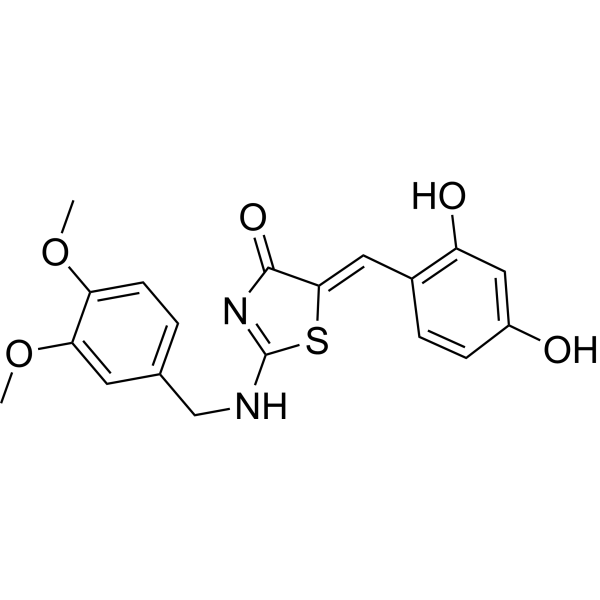
-
- HY-152194
-
|
|
Tyrosinase
|
Cancer
|
|
Tyrosinase-IN-10 (Compound 23) is a partially competitive tyrosinase inhibitor with an IC50 of 1.6 μM against tyrosinase activity from human melanoma cell lysates .
|
-
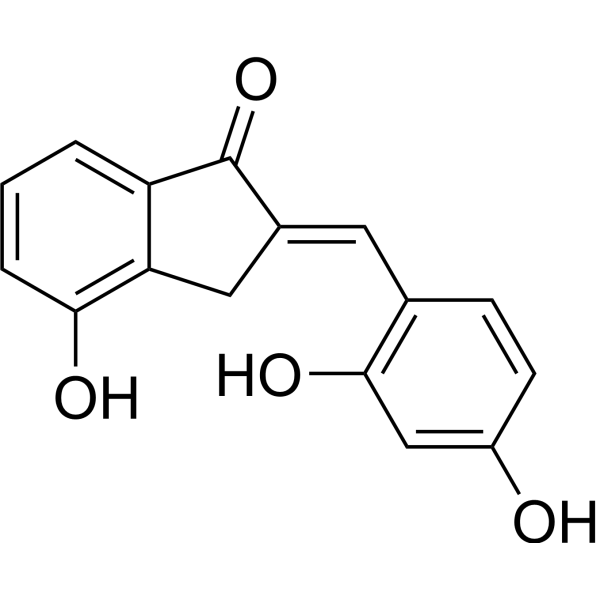
-
- HY-143206
-
|
|
Elastase
|
Others
|
|
Tyrosinase/elastase-IN-1 a triterpenoid from Rubus fraxinifolius leaves, has tyrosinase and elastase inhibitory activities.
|
-
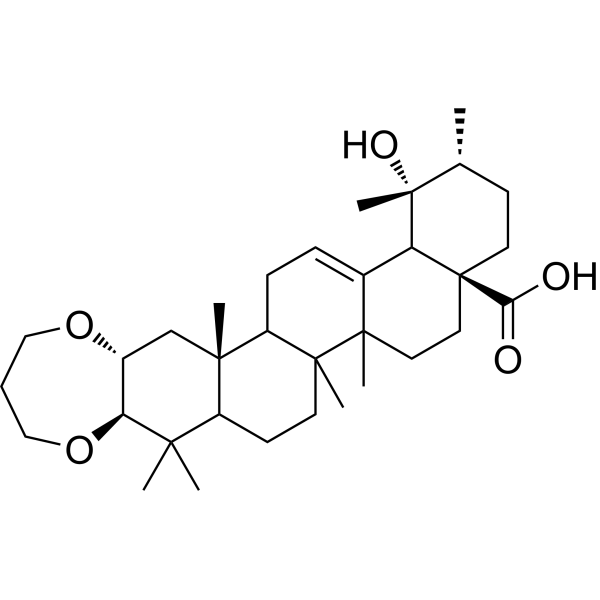
-
- HY-149404
-
|
|
Reactive Oxygen Species
Tyrosinase
|
Others
|
|
Non-competitive tyrosinase inhibitor (Tyrosinase-IN-12) is a potent, non-competitive tyrosinase inhibitor with an IC50 value of 49.33 ± 2.64 µM and Ki value of 31.25 ± 0.25 µM. Non-competitive tyrosinase inhibitor (Tyrosinase-IN-12) have the highest radical scavenging activity to reduce the production of reactive oxygen species (ROS) with an IC50 value of 25.39 ± 0.77 µM. Non-competitive tyrosinase inhibitor (Tyrosinase-IN-12) can be used for anti-browning substances in the food and agricultural sectors .
|
-
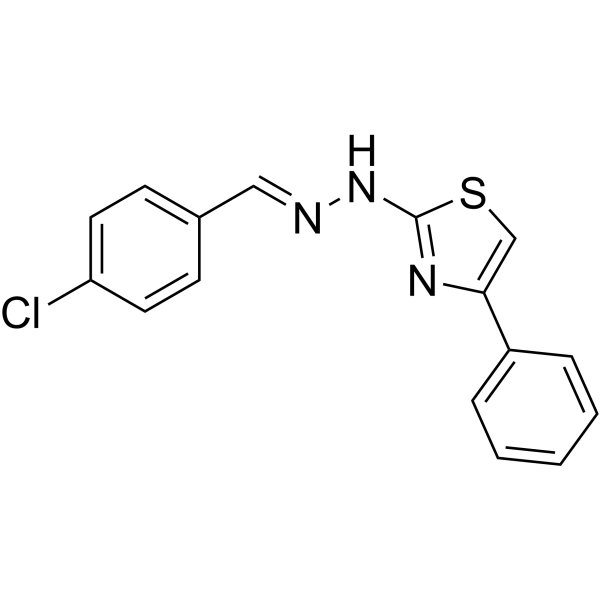
-
- HY-N6244
-
|
|
Tyrosinase
|
Inflammation/Immunology
|
|
Isolindleyin, a butyrophenone, is a tyrosinase inhibitor, with a Kd of 54.8 μM for human tyrosinase. Isolindleyin exhibits anti-inflammatory, analgesic and anti-melanogenic activities .
|
-

-
- HY-N3091
-
|
|
Tyrosinase
|
Others
|
|
Persiconin is a tyrosinase Inhibitor. Persiconin can be isolated from Prunus persica. Persiconin has tyrosinase inhibitory activity of 46% at 500 μM. Persiconin can be used in whitening research .
|
-
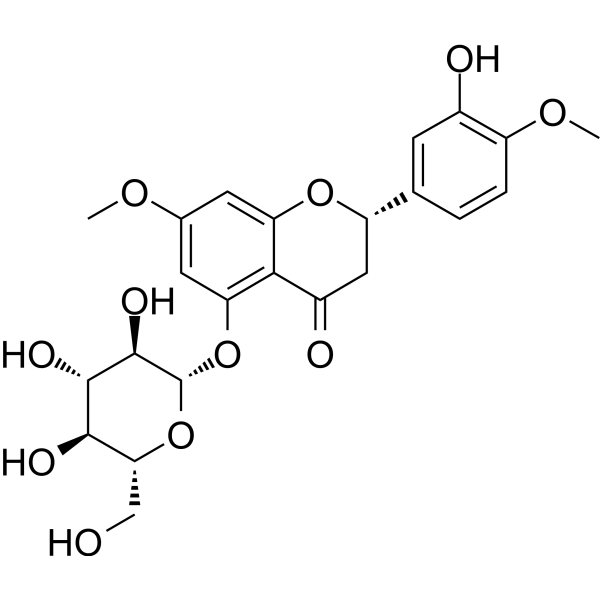
-
- HY-N3200
-
|
|
Tyrosinase
|
Cancer
|
|
Neorauflavane is a potent tyrosinase inhibitor derived from Campylotropis hirtella, with an IC50 value of 30 nM for tyrosinase monophenolase activity and an IC50 value of 500 nM for diphenolase activity. Neorauflavane can effectively reduce the melanin content of B16 melanoma cells .
|
-

-
- HY-N2204
-
|
|
|
|
|
Swertiajaponin is a tyrosinase inhibitor, forms multiple hydrogen bonds and hydrophobic interactions with the binding pocket of tyrosinase, with an IC50 of 43.47 μM. Swertiajaponin also inhibits oxidative stress-mediated MAPK/MITF signaling, leading to decrease in tyrosinase protein level. Swertiajaponin suppresses melanin accumulation and exhibits strong anti-oxidative activity .
|
-

-
- HY-139857
-
|
|
Tyrosinase
|
Others
|
|
Piceid 6″-O-azelaic acid ester shows high intracellular tyrosinase inhibitory and depigmentating activities.
|
-
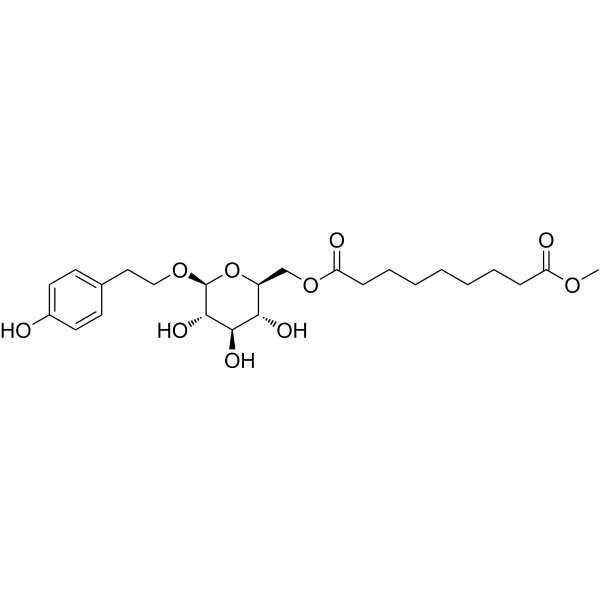
-
- HY-N10286
-
|
|
Tyrosinase
|
Others
|
|
Chetoseminudin B possesses mushroom tyrosinase inhibitory activity with IC50 of 31.7 μM .
|
-
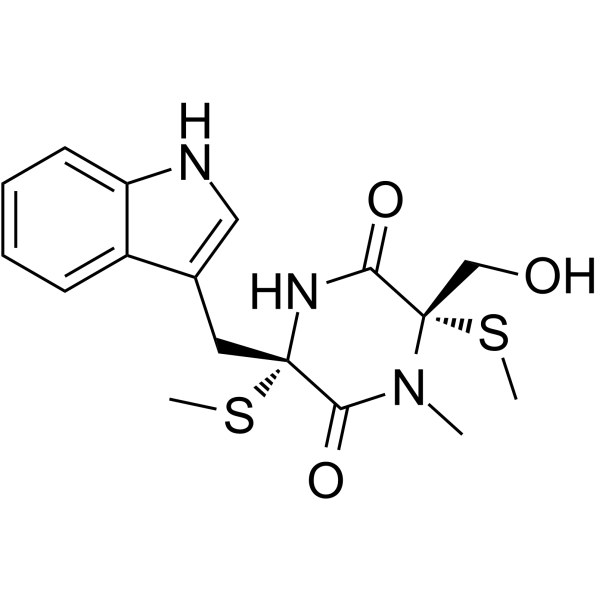
-
- HY-N7929
-
|
|
Tyrosinase
|
Cancer
|
|
5-Feruloylquinic acid (5-FQA) possesses antioxidative effects and tyrosinase inhibitory activities .
|
-
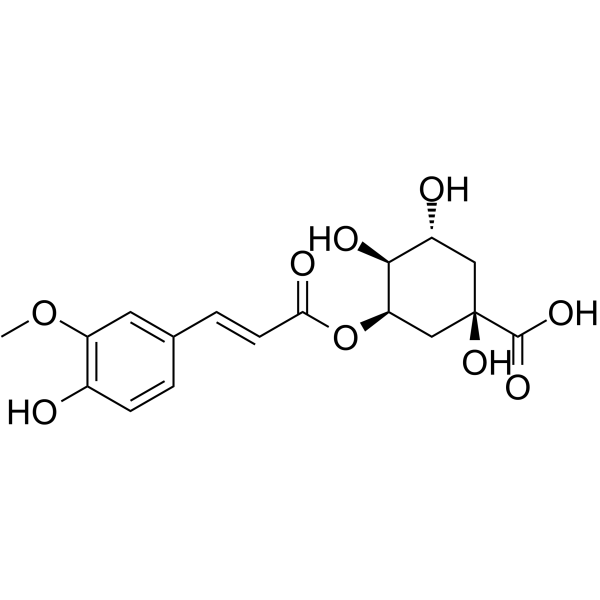
-
- HY-B1461
-
|
|
Tyrosinase
|
Others
|
|
Deoxyarbutin can effectively inhibit tyrosinase activity and melanin synthesis, thereby achieving significant and lasting whitening effects, and has a strong antioxidant effect.
|
-

-
- HY-147709
-
|
|
Tyrosinase
|
Others
|
|
Compound 4B proved to be the most effective tyrosinase inhibitor (ic50= 3.80 μ M) It also showed good antioxidant activity.
|
-

-
- HY-N3943
-
|
|
Tyrosinase
|
Neurological Disease
|
|
Glabrene, an isoflavene derived from licorice root, shows estrogen-like activity. Glabrene is a tyrosinase inhibitor with an IC50 of 3.5 μM .
|
-
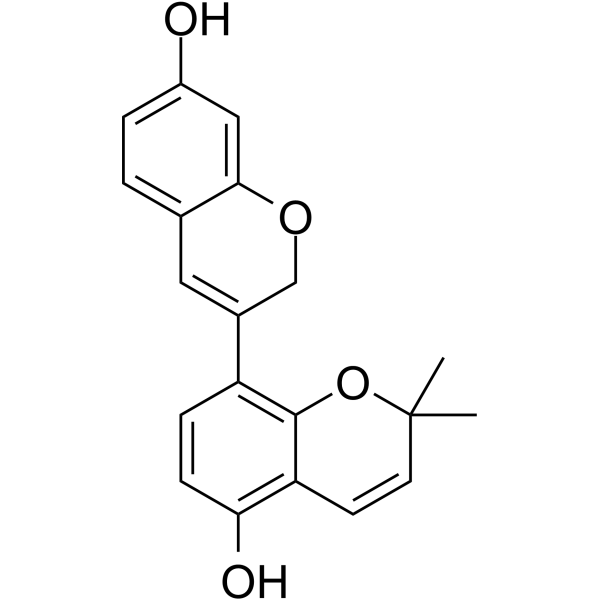
-
- HY-N3912
-
|
|
Bacterial
|
Infection
Cancer
|
|
Furomollugin is a natural product with antioxidant and antibacterial activities, can be isolated from Rubia cordifolia. Furomollugin lacks potent anti-tyrosinase activity, but also exhibits significant anticancer property .
|
-
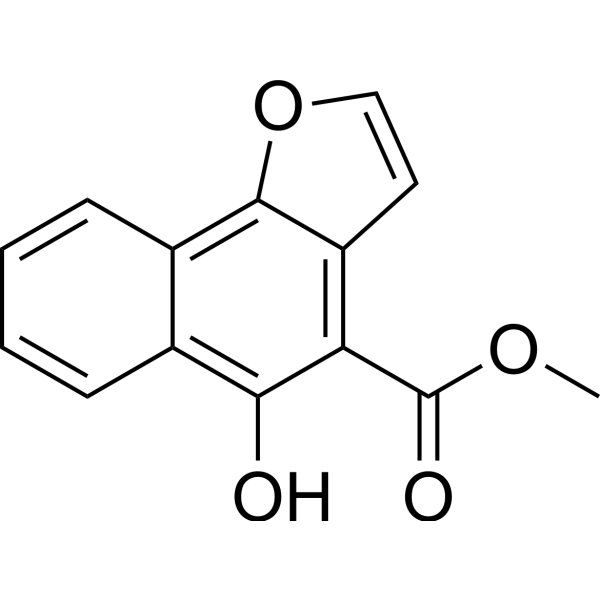
-
- HY-N1238
-
|
Δ4-Sitosterol-3-one; β-Rosasterol oxide
|
|
|
|
β-Sitostenone is a sterols that can be isolated from Cochlospermum vitifolium.β-Sitostenone inhibits tyrosinase activity, and has anti-melanogenic and anti-tumor activities .
|
-
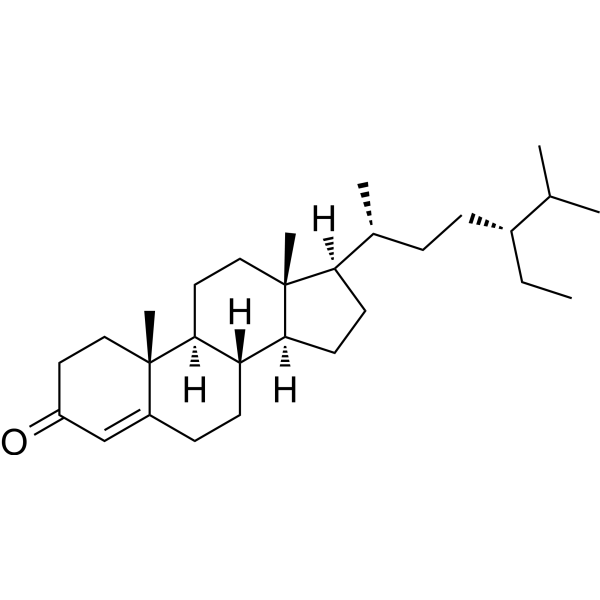
-
- HY-126052
-
|
|
COX
Tyrosinase
HDAC
|
Metabolic Disease
Cancer
|
|
Gnetol is a phenolic compound isolated from the root of Gnetum montanum . Gnetol potently inhibits COX-1 (IC50 of 0.78 μM) and HDAC. Gnetol is a potent tyrosinase inhibitor with an IC50 of 4.5 μM for murine tyrosinase and suppresses melanin biosynthesis. Gnetol has antioxidant, antiproliferative, anticancer and hepatoprotective activity. Gnetol also possesses concentration-dependent α-Amylase, α-glucosidase, and adipogenesis activities .
|
-
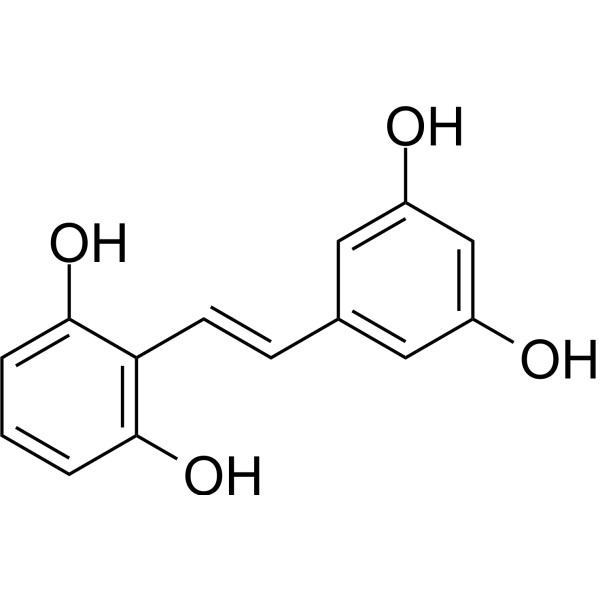
-
- HY-117761
-
|
|
PPAR
|
Metabolic Disease
Cancer
|
|
MHY908 is a potent dual agonist of PPARα and PPARγ . MHY908 also inhibits melanogenesis through inhibition of mushroom tyrosinase activity .
|
-
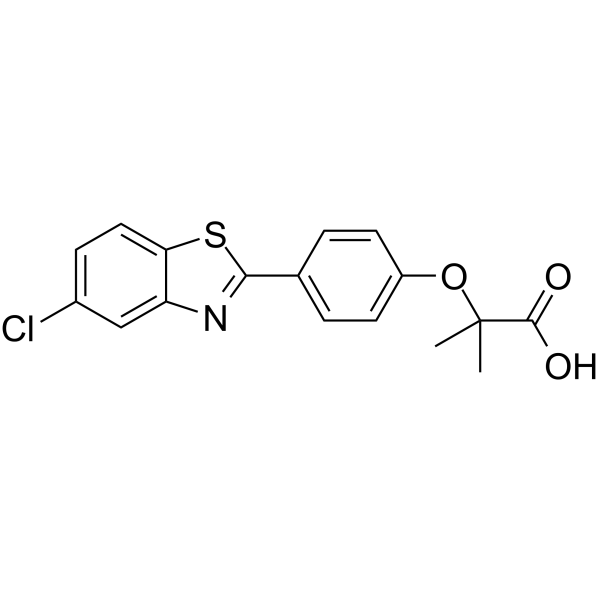
-
- HY-N3773
-
|
|
Tyrosinase
|
Cancer
|
|
Dodoviscin A is a pigmentation-altering agent, which can be isolated from the aerial parts of Dodonaea viscosa. Dodoviscin A inhibits melanin production in B16-F10 melanoma cells. Dodoviscin A suppresses mushroom tyrosinase activity, and tyrosinase activity induced by 3-isobutyl-1-methylxanthine. Dodoviscin A also inhibits the phorphosylation of cAMP response element binding protein, induced by 3-isobutyl-1-methylxanthine and forskolin .
|
-

-
- HY-N0616
-
|
|
Tyrosinase
|
Inflammation/Immunology
Cancer
|
|
Trifolirhizin is a pterocarpan flavonoid isolated from the roots of Sophora flavescens. Trifolirhizin possesses potent tyrosinase inhibitory activity with an IC50 of 506 μM . Trifolirhizin exhibits potential anti-inflammatory and anticancer activities .
|
-
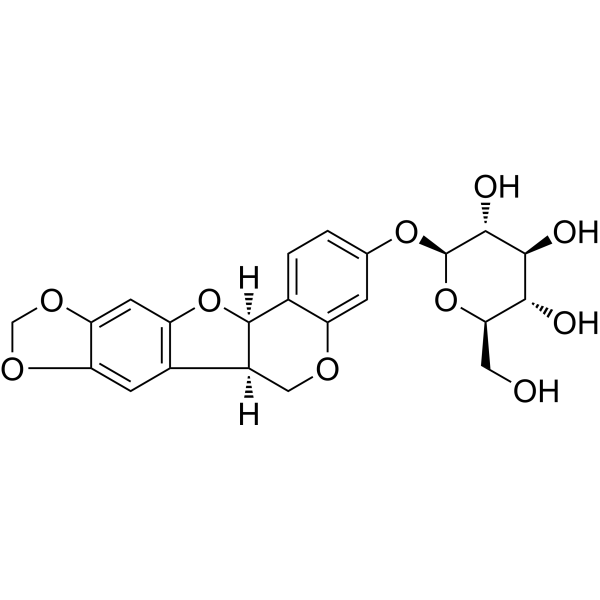
-
- HY-N2460
-
-
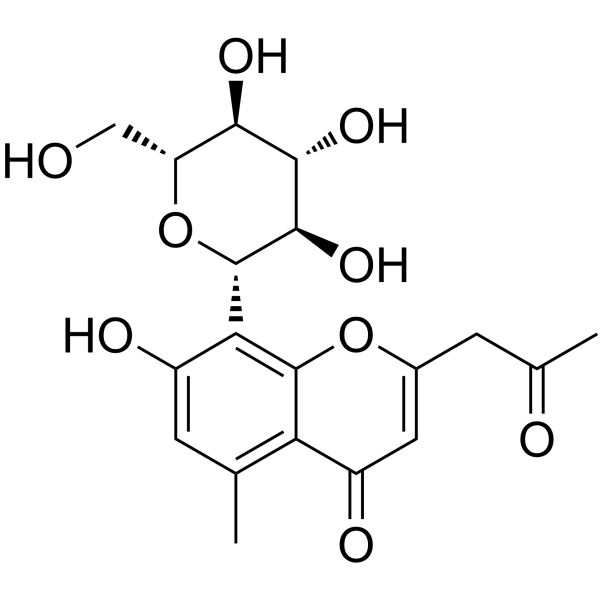
-
- HY-N3674
-
|
|
TGF-beta/Smad
|
Inflammation/Immunology
|
|
Dalbergioidin, a well-known anthocyanin, ameliorates doxorubicin-induced renal fibrosis by suppressing the TGF-β signal pathway. Dalbergioidin exhibits tyrosinase inhibitory activity with an IC50 of 20 mM .
|
-
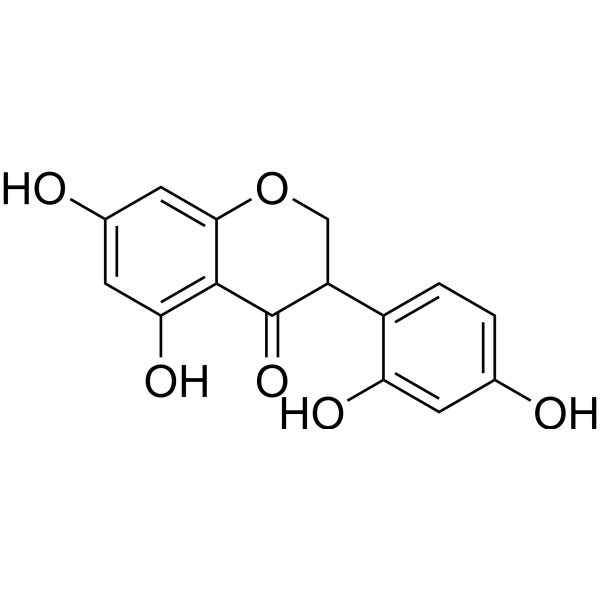
-
- HY-N7587
-
|
|
Melanocortin Receptor
|
Metabolic Disease
|
|
Chlorophorin is a inhibitor of Melanocortin Receptor. Chlorophorin reduces tyrosinase activity and inhibits a-melanocyte-stimulating hormone-induced melanin production in B16F10 melanoma cells .
|
-

-
- HY-N10285
-
|
|
Tyrosinase
|
Infection
|
|
Phaeosphaone D is a thiodiketopiperazine alkaloid compound isolated from Phaeosphaeria fuckelii, an endophytic fungus. Phaeosphaone D displays mushroom tyrosinase inhibitory activity with an IC50 value of 33.2 μM .
|
-
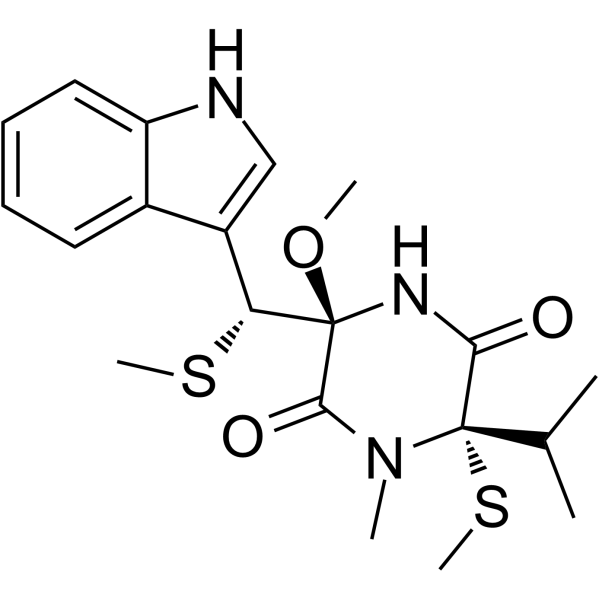
-
- HY-Y0729
-
|
|
Tyrosinase
Bacterial
Fungal
|
Infection
|
|
4-Chlorocinnamic acid has inhibitory effects on tyrosinase. 4-Chlorocinnamic acid has antibacterial activity. 4-Chlorocinnamic acid also inhibits Colletotrichum gloeosporioides growth .
|
-
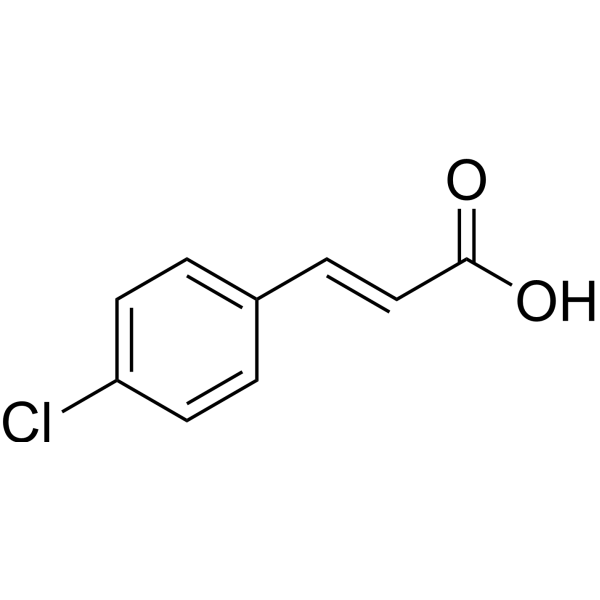
-
- HY-W019829
-
|
|
Tyrosinase
Parasite
|
Infection
|
|
Polyphyllin C (compound 2) is a spirostanol saponin. Polyphyllin C exhibits mild (IC50=36.87 µM) activities against the tyrosinase and moderate (IC50=1.59 µg/mL) antileishmanial activities .
|
-
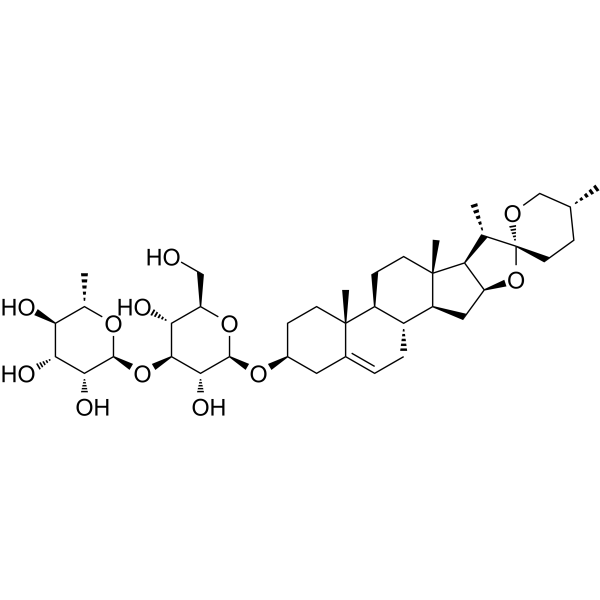
-
- HY-N0136
-
Taxifolin
Maximum Cited Publications
11 Publications Verification
(+)-Dihydroquercetin; (+)-Taxifolin
|
Autophagy
Tyrosinase
|
Inflammation/Immunology
|
|
Taxifolin ((+)-Dihydroquercetin) exhibits important anti-tyrosinase activity. Taxifolin exhibits significant inhibitory activity against collagenase with an IC50 value of 193.3 μM . Taxifolin is an important natural compound with antifibrotic activity. Taxifolin is a free radical scavenger with antioxidant capacity .
|
-
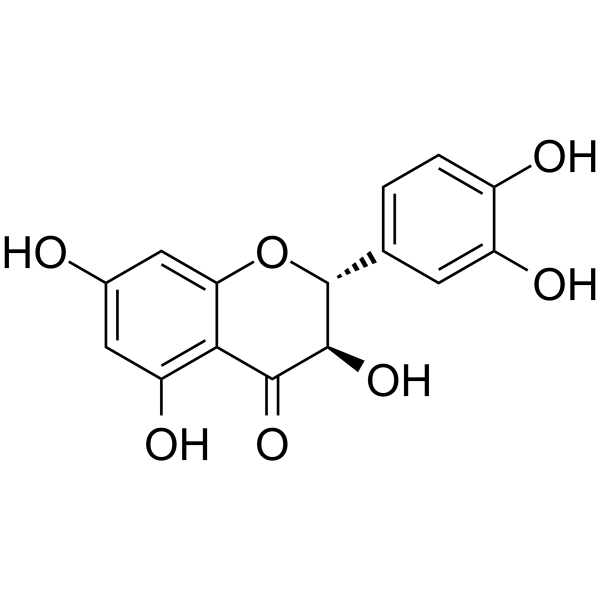
-
- HY-N0637A
-
|
(±)-Huazhongilexone; Dihydroluteolin
|
Melanocortin Receptor
|
Metabolic Disease
|
|
(±)-Eriodictyol ((±)-Huazhongilexone), a flavonoid, is a potent melanogenesis inhibitor with an IC50 of 48 μM. (±)-Eriodictyol suppresses tyrosinase, TRP-1, and TRP-2 mRNA expression. (±)-Eriodictyol has strong anti-plasmin activities .
|
-
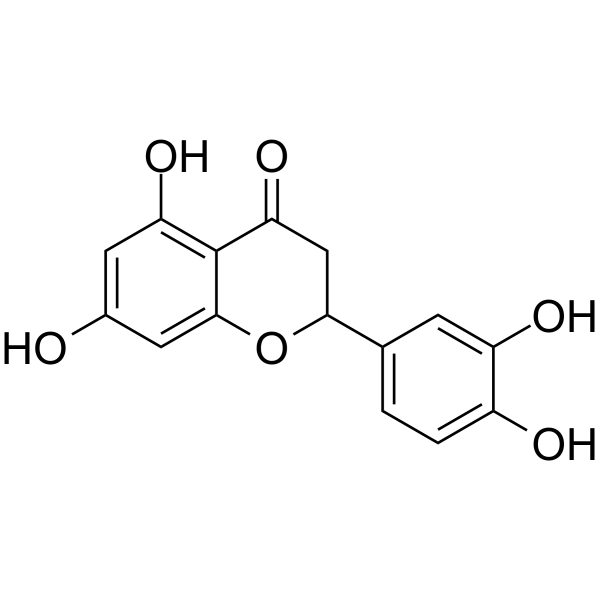
-
- HY-N3518
-
|
|
Tyrosinase
|
Metabolic Disease
|
|
Mulberroside F is one of the main bioactive constituents in mulberry (Morus alba L.) . Mulberroside F shows inhibitory effects on tyrosinase activity and on the melanin formation. Mulberroside F also exhibits superoxide scavenging activity that is involved in the protection against auto-oxidation .
|
-

-
- HY-N0136A
-
|
(±)-Dihydroquercetin
|
Autophagy
Tyrosinase
|
Inflammation/Immunology
|
|
(±)-Taxifolin ((±)-Dihydroquercetin) is the racemate of Taxifolin. Taxifolin exhibits important anti-tyrosinase activity. Taxifolin exhibits significant inhibitory activity against collagenase with an IC50 value of 193.3 μM . Taxifolin is an important natural compound with antifibrotic activity. Taxifolin is a free radical scavenger with antioxidant capacity .
|
-
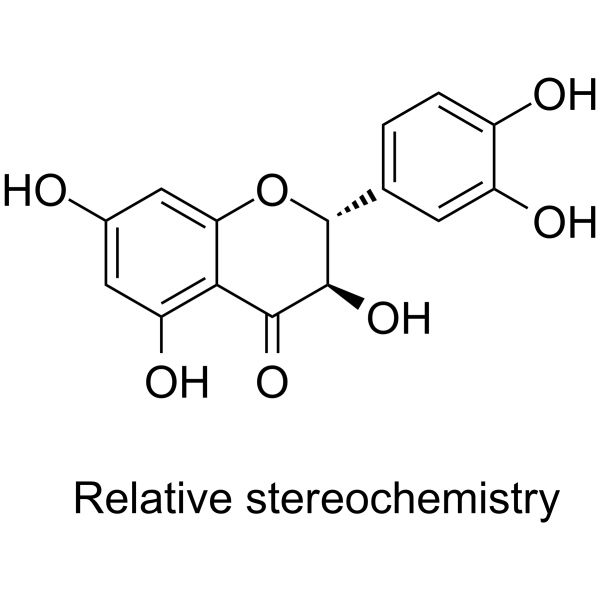
-
- HY-N10503
-
|
|
Tyrosinase
Ras
Raf
MAPKAPK2 (MK2)
Apoptosis
|
Cancer
|
|
Norartocarpetin is a tyrosinase inhibitor. Norartocarpetin has strong tyrosinase inhibitory activity with an IC50 value of 0.47 μM. Norartocarpetin as an antibrowning agent can be used for the research of food systems. Norartocarpetin also has a significant anticancer activity in lung carcinoma cells (NCI-H460) with an IC50 value of 22 μM. Norartocarpetin has antiproliferative effects are mediated via targeting Ras/Raf/MAPK signalling pathway, mitochondrial mediated apoptosis, S-phase cell cycle arrest and suppression of cell migration and invasion in human lung carcinoma cells .
|
-

-
- HY-W013571
-
|
|
Fungal
|
Infection
|
|
4-Isopropylbenzoic acid, an aromatic monoterpenoid, is isolated from the stem bark of Bridelia retusa. 4-Isopropylbenzoic acid exhibits antifungal activities. 4-Isopropylbenzoic acid is also a reversible and uncompetitive inhibitor of mushroom tyrosinase .
|
-

-
- HY-N0136B
-
|
(-)-Dihydroquercetin
|
Tyrosinase
|
Inflammation/Immunology
|
|
(-)-Taxifolin is the less active enantiomer of Taxifolin. Taxifolin exhibits important anti-tyrosinase activity. Taxifolin exhibits significant inhibitory activity against collagenase with an IC50 value of 193.3 μM . Taxifolin is an important natural compound with antifibrotic activity. Taxifolin is a free radical scavenger with antioxidant capacity .
|
-

-
- HY-Y0444
-
|
|
Tyrosinase
|
Metabolic Disease
|
|
D-Tyrosine is the D-isomer of tyrosine. D-Tyrosine negatively regulates melanin synthesis by inhibiting tyrosinase activity. D-Tyrosine inhibits biofilm formation and trigger the self-dispersal of biofilms without suppressing bacterial growth .
|
-
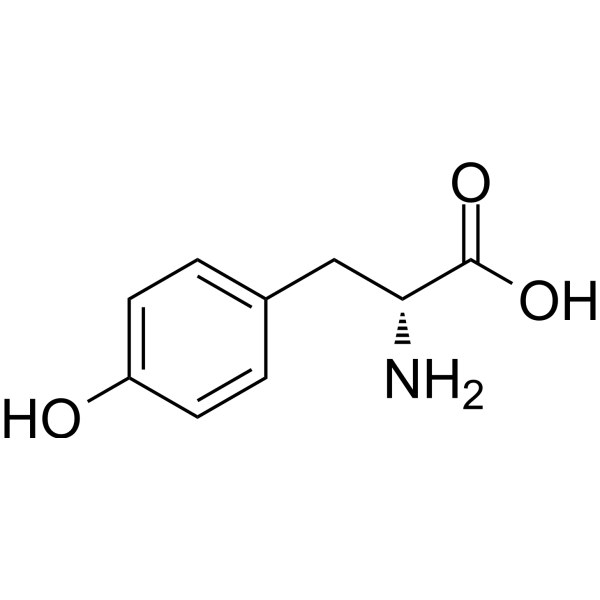
-
- HY-N3023
-
|
NSC 263475 hydrobromide
|
DNA/RNA Synthesis
|
Cancer
|
|
3,4-Dihydroxybenzylamine hydrobromide (NSC 263475 hydrobromide) is an improved dopamine analog cytotoxic and inhibits DNA polymerase activity in melanoma cells . 3,4-Dihydroxybenzylamine hydrobromide (NSC 263475 hydrobromide) displays growth inhibitory activity in melanoma cell lines with varying degrees of tyrosinase activity .
|
-
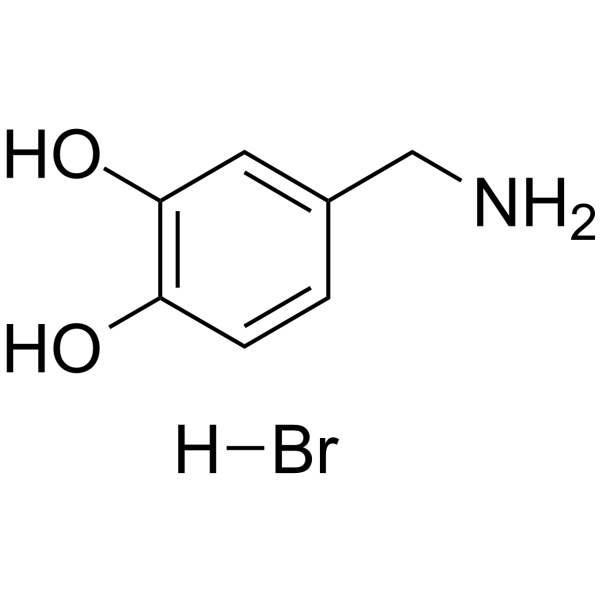
-
- HY-133680
-
|
|
Tyrosinase
|
Metabolic Disease
|
|
β-Tocopherol is an analogue of vitamin E, exhibits antioxidant properties. β-Tocopherol can inhibit tyrosinase activity and melanin synthesis. β-Tocopherol also can prevent the inhibition of cell growth and of PKC activity caused by d-alpha-tocopherol .
|
-

-
- HY-116750
-
|
|
Tyrosinase
|
Others
|
|
6-Hydroxykaempferol, a flavonoid, is a competitive tyrosinase inhibitor with an IC50 value of 124 μM. 6-Hydroxykaempferol has a Ki value of 148 μM relative to L-DOPA as a substrate and effectively inhibits the activity of the enzyme by binding to the active site of the enzyme .
|
-
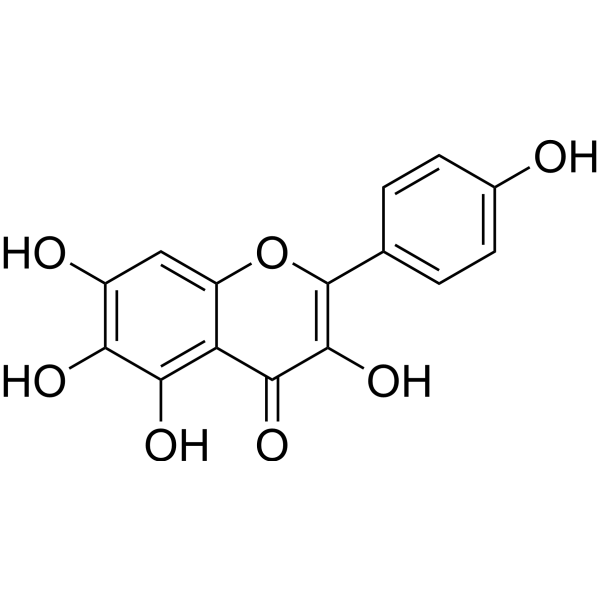
-
- HY-N1170
-
|
(2R)-Taxiphyllin
|
Others
Tyrosinase
|
Others
|
Taxiphyllin (2R-Taxiphyllin) is a plant cyanogenic glycoside, which exhibits inhibitory activity for tyrosinase . Taxiphyllin exhibits cytotoxicity in BRL-3A cellls with an IC50 of 18.75 μm and antimicrobial activities against Staphylococcus aureus with an EC50 of 0.96 μM .
|
-
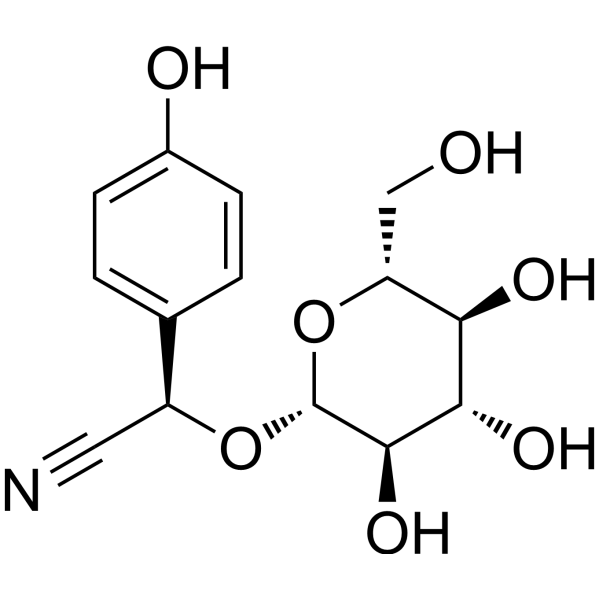
-
- HY-N10016
-
|
|
Tyrosinase
|
Cancer
|
|
Chlorogenic acid butyl ester, a caffeoylquinic acid, is a potent melanogenesis inhibitor. Chlorogenic acid butyl ester inhibits the expression of microphtalmia-associated transcription factor (MITF), tyrosinase, tyrosinerelated protein 1 (TRP-1), and TRP-2. Chlorogenic acid butyl ester also shows antioxidant activity .
|
-
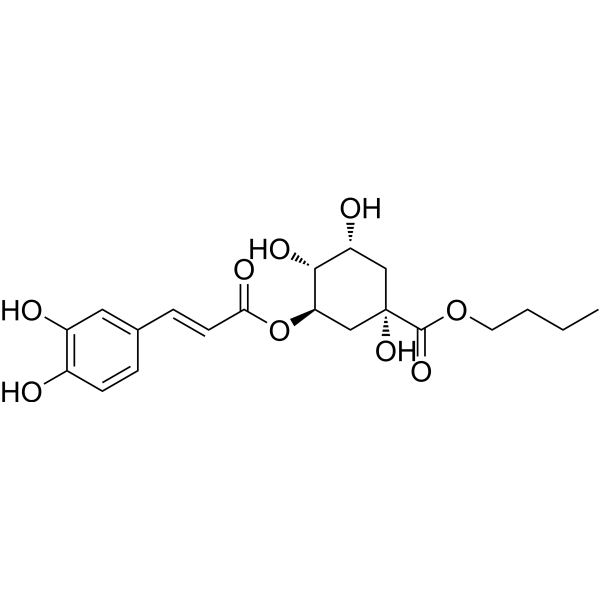
-
- HY-P3645
-
|
|
Melanocortin Receptor
|
Others
|
|
(Nle4)-α-MSH is a synthetic analogue of α-MSH (HY-P0252), a melanocyte-stimulating hormone. (Nle4)-α-MSH reversibly darkens frog skins and also exhibits prolonged activity after heat-alkali treatment .
|
-
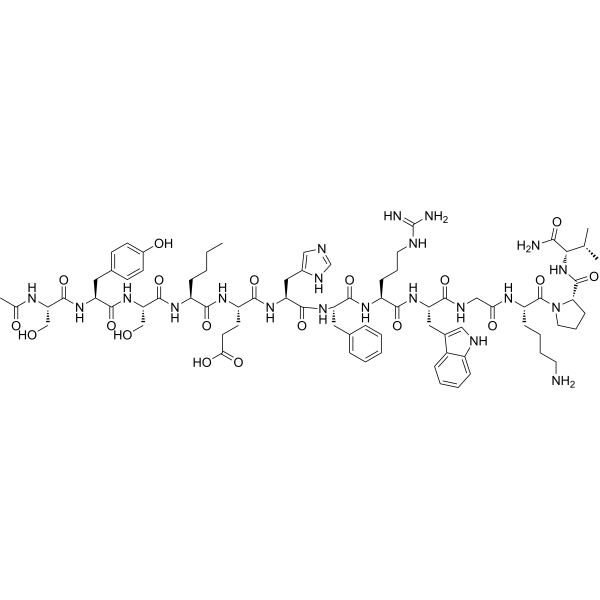
-
- HY-N0136S
-
|
(+)-Dihydroquercetin-d3; (+)-Taxifolin-d3
|
Isotope-Labeled Compounds
Autophagy
Tyrosinase
|
Inflammation/Immunology
|
|
Taxifolin-d3 is deuterium labeled Taxifolin. Taxifolin ((+)-Dihydroquercetin) exhibits important anti-tyrosinase activity. Taxifolin exhibits significant inhibitory activity against collagenase with an IC50 value of 193.3 μM[1]. Taxifolin is an important natural compound with antifibrotic activity. Taxifolin is a free radical scavenger with antioxidant capacity[2].
|
-
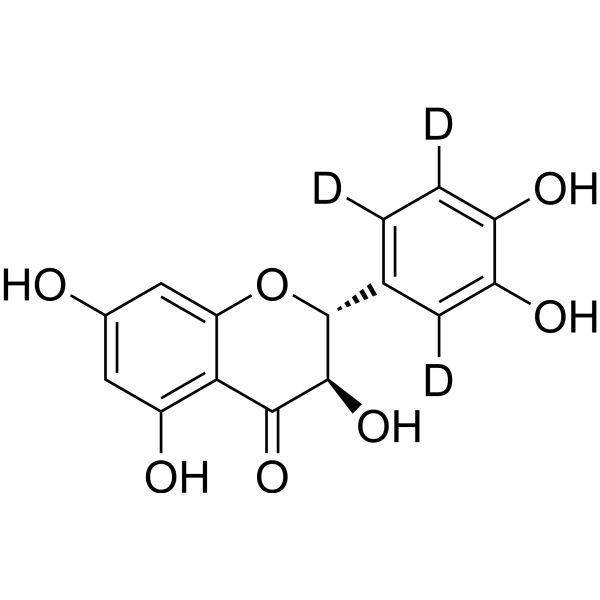
-
- HY-113068
-
|
|
Tyrosinase
|
Metabolic Disease
|
|
(rel)-β-Tocopherol is a relative configuration of β-Tocopherol.(±)-β-Tocopherol is a lipid-soluble form of vitamin E with antioxidant activity. β-Tocopherol can inhibit tyrosinase activity and melanin synthesis. β-Tocopherol also can prevent the inhibition of cell growth and of PKC activity caused by d-alpha-tocopherol .
|
-
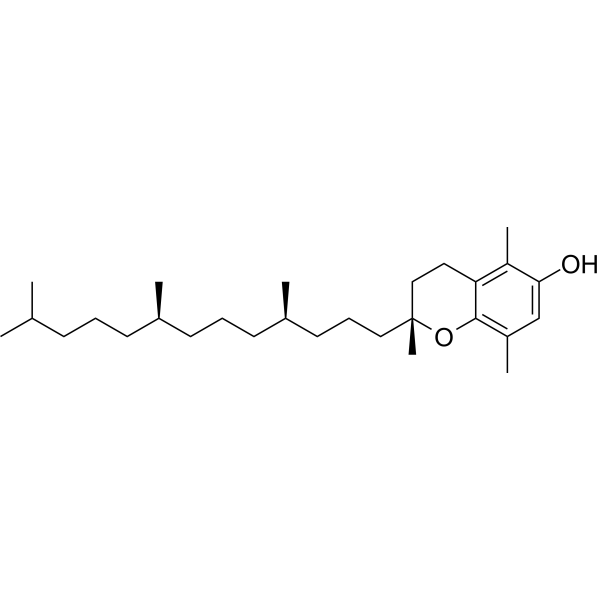
-
- HY-N2472
-
|
Castanogenin
|
Bacterial
|
Infection
|
|
Medicagenic acid (Castanogenin) is isolated from the roots of Herniaria glabra, exhibits potent fungistatic effects against several plant pathogens and human dermatophytes . Medicagenic acid (Castanogenin) has low enzyme inhibitory activities, the target enzymes are xanthine oxidase, collagenase, elastase, tyrosinase, ChE .
|
-
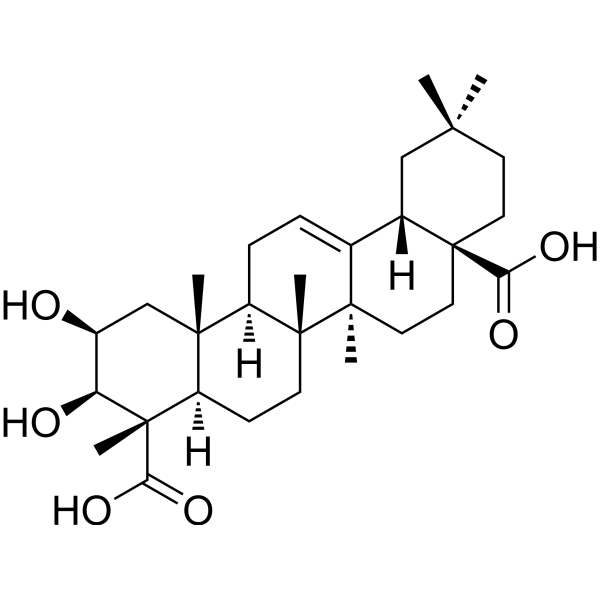
-
- HY-N2902
-
|
|
Others
|
Cancer
|
|
Artocarpin is an isoprenoid-substituted flavonoid, that can be isolated from the wood of Artocarpus heterophyllus. Artocarpin inhibits melanin biosynthesis in B16 melanoma cells without inhibiting tyrosinase. The presence of the isoprenoid-substituted moiety enhanced the inhibitory activity on melanin production in B16 melanoma cells .
|
-
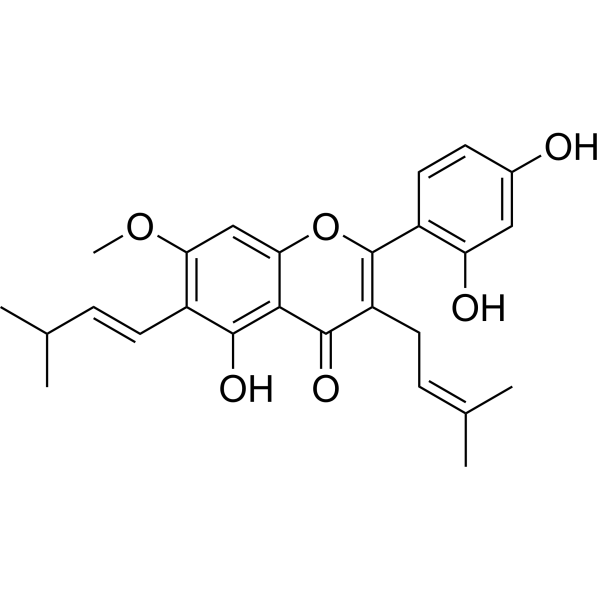
-
- HY-N1780
-
|
|
|
|
|
3,4-Dimethoxyphenol is a plant-derived phenylpropanoid compound and can use as a whitening agent in cosmetics. 3,4-Dimethoxyphenol has tyrosinase-inhibiting activity . 3,4-Dimethoxyphenol has potent antioxidant effect isolated from the bacterial fermentation broth .
|
-
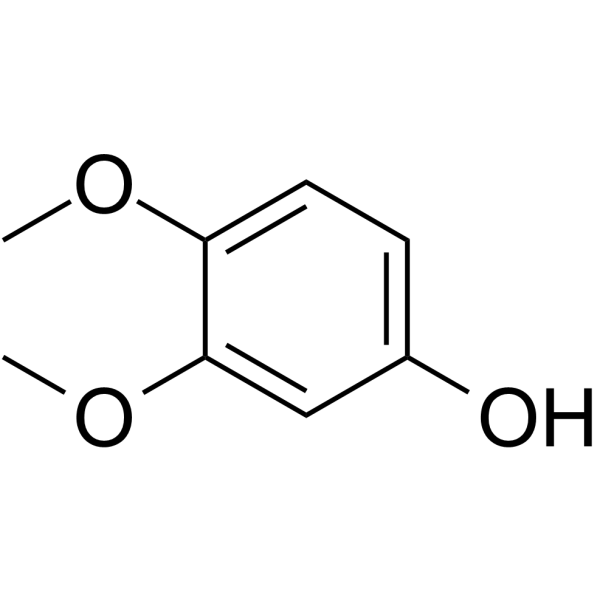
-
- HY-N1775
-
|
3,4-DHAP
|
|
|
|
3',4'-Dihydroxyacetophenone (3,4-DHAP), isolated from Picea Schrenkiana Needles exhibits a strong suppressive action against tyrosinase activity, with an IC50 of 10 μM. 3',4'-Dihydroxyacetophenone (3,4-DHAP) is a vasoactive agent and antioxidant .
|
-
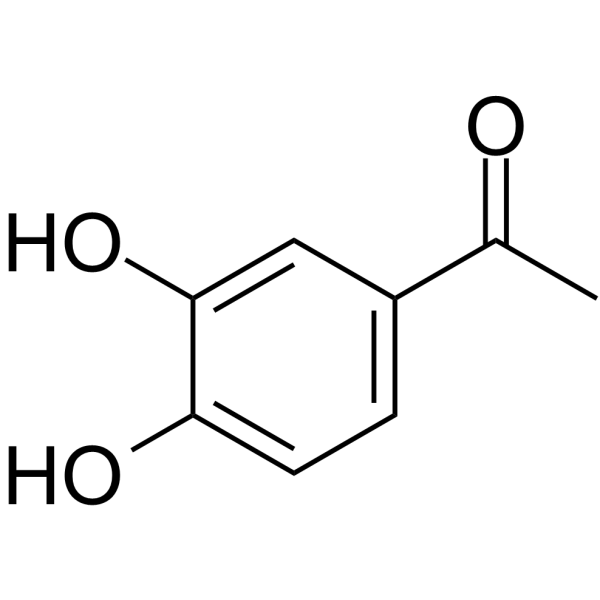
- HY-N4005
-
|
|
Bacterial
Tyrosinase
|
Infection
Neurological Disease
|
|
Isoastilbin is a dihydroflavonol glycoside compound in Rhizoma Smilacis glabrae and Astragalus membranaceus. Isoastilbin inhibits glucosyltransferase (GTase) with an IC50 value of 54.3 μg/mL, and also inhibits tyrosinase activity. Isoastilbin shows neuroprotective, antioxidation, antimicrobial and anti-apoptotic properties and has the potential for Alzheimer’s disease research .
|
-
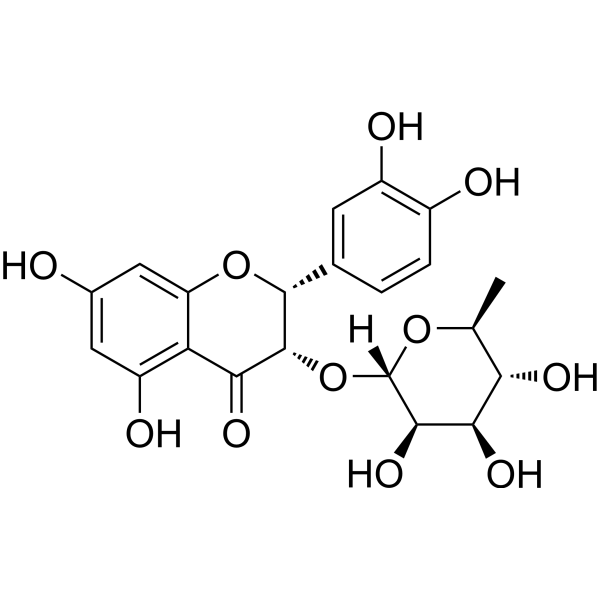
- HY-Y0444S
-
|
|
Isotope-Labeled Compounds
Tyrosinase
|
|
|
D-Tyrosine-d2 is the deuterium labeled D-Tyrosine. D-Tyrosine is the D-isomer of tyrosine. D-Tyrosine negatively regulates melanin synthesis by inhibiting tyrosinase activity. D-Tyrosine inhibits biofilm formation and trigger the self-dispersal of biofilms without suppressing bacterial growth[1][2].
|
-

- HY-Y0444S1
-
|
|
Tyrosinase
|
|
|
D-Tyrosine-d4 is the deuterium labeled D-Tyrosine. D-Tyrosine is the D-isomer of tyrosine. D-Tyrosine negatively regulates melanin synthesis by inhibiting tyrosinase activity. D-Tyrosine inhibits biofilm formation and trigger the self-dispersal of biofilms without suppressing bacterial growth[1][2].
|
-

- HY-Y0444S2
-
|
|
Isotope-Labeled Compounds
Tyrosinase
|
|
|
D-Tyrosine-d7 is the deuterium labeled D-Tyrosine. D-Tyrosine is the D-isomer of tyrosine. D-Tyrosine negatively regulates melanin synthesis by inhibiting tyrosinase activity. D-Tyrosine inhibits biofilm formation and trigger the self-dispersal of biofilms without suppressing bacterial growth[1][2].
|
-
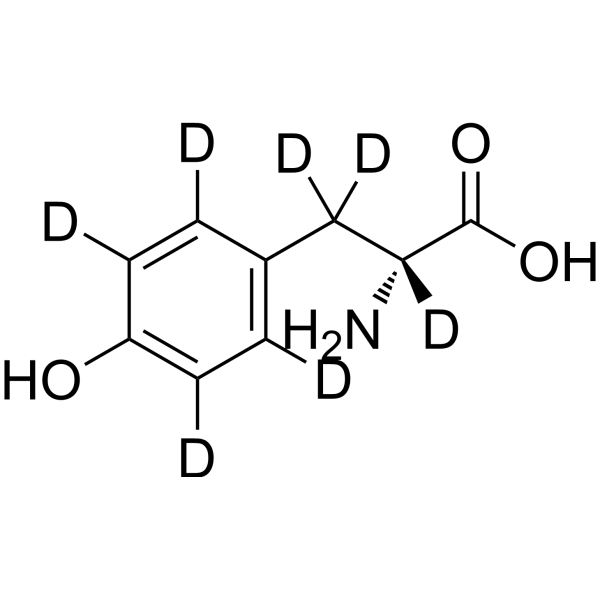
- HY-B0856
-
|
|
|
|
|
Validamycin A, a fungicidal, is an agricultural antibiotic. Validamycin A is originally isolated from Streptomyces hygroscopicus var. limoneus. Validamycin A inhibits the growth of A. flavus, with a MIC of 1 μg/mL . Validamycin A shows potent inhibitory activity against trehalase of Rhizoctonia solani, with an IC50 of 72 μM . Validamycin A is a reversible tyrosinase inhibitor, with a Ki of 5.893 mM .
|
-
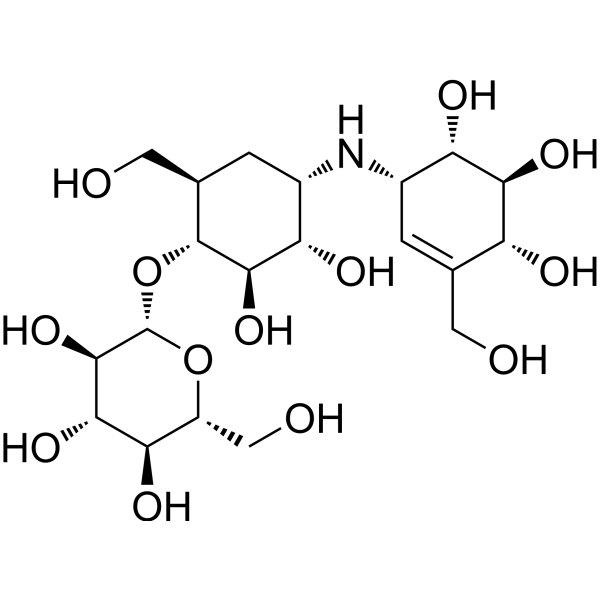
- HY-113068S
-
|
|
Isotope-Labeled Compounds
Tyrosinase
|
Metabolic Disease
|
|
β-Tocopherol-d3 is the deuterium labeled β-Tocopherol. β-Tocopherol is an analogue of vitamin E, exhibits antioxidant properties. β-Tocopherol can inhibit tyrosinase activity and melanin synthesis. β-Tocopherol can also prevent the inhibition of cell growth and of PKC activity caused by d-alpha-tocopherol[1][2][3].
|
-
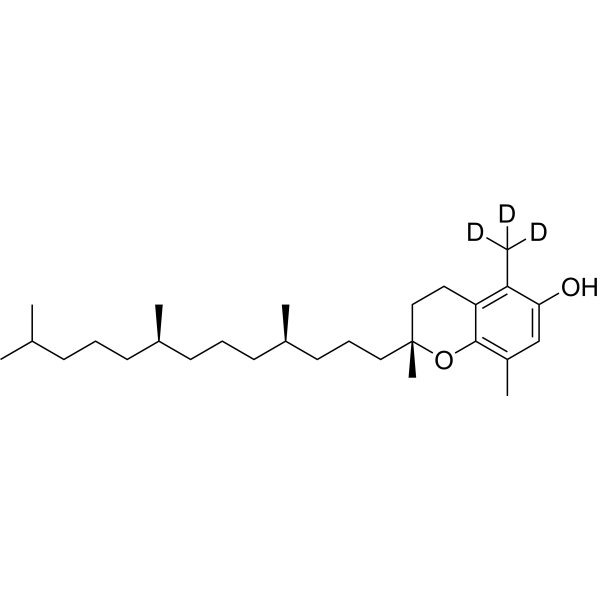
- HY-N0136S1
-
|
(±)-Dihydroquercetin-13C3
|
Autophagy
Tyrosinase
|
Inflammation/Immunology
|
|
(±)-Taxifolin-13C3 ((±)-Dihydroquercetin-13C3) is a derivative of (±)-Taxifolin, labeled with 13C3. (±)-Taxifolin is the racemate of Taxifolin. Taxifolin exhibits important anti-tyrosinase activity. Taxifolin exhibits significant inhibitory activity against collagenase with an IC50 value of 193.3 μM . Taxifolin is an important natural compound with antifibrotic activity. Taxifolin is a free radical scavenger with antioxidant capacity .
|
-

- HY-W017212
-
|
Methyl 3-phenylpropenoate
|
Tyrosinase
Bacterial
AMPK
|
Infection
Metabolic Disease
|
|
Methyl cinnamate (Methyl 3-phenylpropenoate), an active component of Zanthoxylum armatum, is a widely used natural flavor compound. Methyl cinnamate (Methyl 3-phenylpropenoate) possesses antimicrobial activity and is a tyrosinase inhibitor that can prevent food browning. Methyl cinnamate (Methyl 3-phenylpropenoate) has antiadipogenic activity through mechanisms mediated, in part, by the CaMKK2-AMPK signaling pathway .
|
-
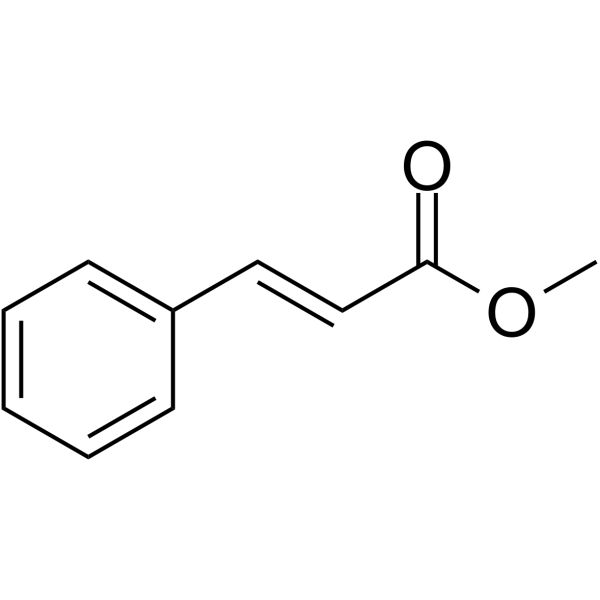
- HY-P99622
-
|
IMC-20D7S
|
Tyrosinase
|
Cancer
|
|
Flanvotumab (IMC-20D7S) is a human monoclonal antibody targeting to tyrosinase-related protein (TYRP1), specifically expressed in melanocytes and melanoma cells. Flanvotumab acts function via natural killing-mediated antibody-dependent cell-mediated cytotoxicity (ADCC). Flanvotumab has potent anti-tumor activity and good tolerance .
|
-

- HY-N0619
-
|
|
TNF Receptor
Interleukin Related
Tyrosinase
|
Inflammation/Immunology
|
|
Mulberroside A is one of the main bioactive constituent in mulberry (Morus alba L.) . Mulberroside A decreases the expressions of TNF-α, IL-1β, and IL-6 and inhibits the activation of NALP3, caspase-1, and NF-κB and the phosphorylation of ERK, JNK, and p38, exhibiting anti-inflammatory antiapoptotic effects . Mulberroside A shows inhibitory activity against mushroom tyrosinase with an IC50 of 53.6 μM .
|
-

- HY-N0619A
-
|
Mulberroside D
|
TNF Receptor
Interleukin Related
Tyrosinase
|
Inflammation/Immunology
|
|
cis-Mulberroside A (Mulberroside D) is the cis-isomer of Mulberroside A. Mulberroside A is one of the main bioactive constituent in mulberry (Morus alba L.) . Mulberroside A decreases the expressions of TNF-α, IL-1β, and IL-6 and inhibits the activation of NALP3, caspase-1, and NF-κB and the phosphorylation of ERK, JNK, and p38, exhibiting anti-inflammatory and anti-apoptotic effects . Mulberroside A shows inhibitory activity against mushroom tyrosinase with an IC50 of 53.6 μM .
|
-
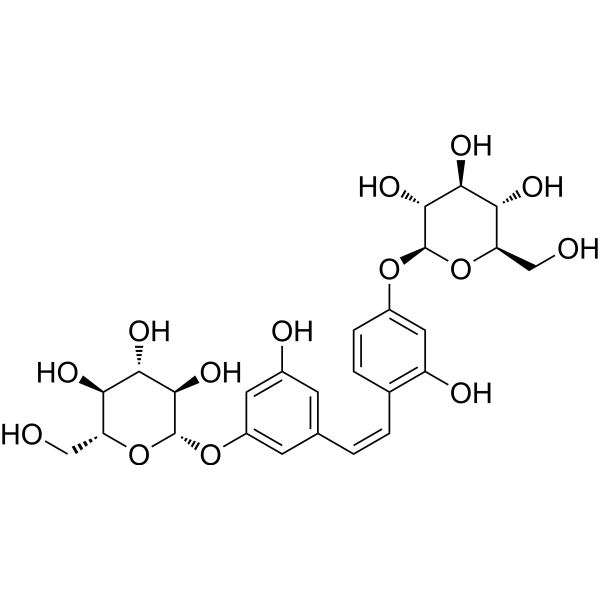
- HY-N2983
-
|
|
Tyrosinase
|
Others
|
|
Cajanin is a potent and orally active anti-melanogenic agent. Cajanin shows antiproliferative activity in MNT1 Cells. Cajanin efficiently decreases the melanin content. Cajanin down-regulates the mRNA and protein expression levels of MITF, tyrosinase, TRP-1 and Dct (TRP-2). Cajanin induces cell cycle arrest at G2/M and S phase. Cajanin stimulates osteoblast proliferation. Cajanin has the potential for the research of human hyperpigmented disorders and menopausal osteoporosis .
|
-

| Cat. No. |
Product Name |
Target |
Research Area |
-
- HY-P3645
-
|
|
Melanocortin Receptor
|
Others
|
|
(Nle4)-α-MSH is a synthetic analogue of α-MSH (HY-P0252), a melanocyte-stimulating hormone. (Nle4)-α-MSH reversibly darkens frog skins and also exhibits prolonged activity after heat-alkali treatment .
|
| Cat. No. |
Product Name |
Target |
Research Area |
-
- HY-P99622
-
|
IMC-20D7S
|
Tyrosinase
|
Cancer
|
|
Flanvotumab (IMC-20D7S) is a human monoclonal antibody targeting to tyrosinase-related protein (TYRP1), specifically expressed in melanocytes and melanoma cells. Flanvotumab acts function via natural killing-mediated antibody-dependent cell-mediated cytotoxicity (ADCC). Flanvotumab has potent anti-tumor activity and good tolerance .
|
| Cat. No. |
Product Name |
Category |
Target |
Chemical Structure |
| Cat. No. |
Product Name |
Chemical Structure |
-
- HY-Y0444S1
-
|
|
|
D-Tyrosine-d4 is the deuterium labeled D-Tyrosine. D-Tyrosine is the D-isomer of tyrosine. D-Tyrosine negatively regulates melanin synthesis by inhibiting tyrosinase activity. D-Tyrosine inhibits biofilm formation and trigger the self-dispersal of biofilms without suppressing bacterial growth[1][2].
|
-

-
- HY-N0136S
-
|
|
|
Taxifolin-d3 is deuterium labeled Taxifolin. Taxifolin ((+)-Dihydroquercetin) exhibits important anti-tyrosinase activity. Taxifolin exhibits significant inhibitory activity against collagenase with an IC50 value of 193.3 μM[1]. Taxifolin is an important natural compound with antifibrotic activity. Taxifolin is a free radical scavenger with antioxidant capacity[2].
|
-

-
- HY-Y0444S
-
|
|
|
D-Tyrosine-d2 is the deuterium labeled D-Tyrosine. D-Tyrosine is the D-isomer of tyrosine. D-Tyrosine negatively regulates melanin synthesis by inhibiting tyrosinase activity. D-Tyrosine inhibits biofilm formation and trigger the self-dispersal of biofilms without suppressing bacterial growth[1][2].
|
-

-
- HY-Y0444S2
-
|
|
|
D-Tyrosine-d7 is the deuterium labeled D-Tyrosine. D-Tyrosine is the D-isomer of tyrosine. D-Tyrosine negatively regulates melanin synthesis by inhibiting tyrosinase activity. D-Tyrosine inhibits biofilm formation and trigger the self-dispersal of biofilms without suppressing bacterial growth[1][2].
|
-

-
- HY-113068S
-
|
|
|
β-Tocopherol-d3 is the deuterium labeled β-Tocopherol. β-Tocopherol is an analogue of vitamin E, exhibits antioxidant properties. β-Tocopherol can inhibit tyrosinase activity and melanin synthesis. β-Tocopherol can also prevent the inhibition of cell growth and of PKC activity caused by d-alpha-tocopherol[1][2][3].
|
-

-
- HY-N0136S1
-
|
|
|
(±)-Taxifolin-13C3 ((±)-Dihydroquercetin-13C3) is a derivative of (±)-Taxifolin, labeled with 13C3. (±)-Taxifolin is the racemate of Taxifolin. Taxifolin exhibits important anti-tyrosinase activity. Taxifolin exhibits significant inhibitory activity against collagenase with an IC50 value of 193.3 μM . Taxifolin is an important natural compound with antifibrotic activity. Taxifolin is a free radical scavenger with antioxidant capacity .
|
-

Your information is safe with us. * Required Fields.
Inquiry Information
- Product Name:
- Cat. No.:
- Quantity:
- MCE Japan Authorized Agent:






































































